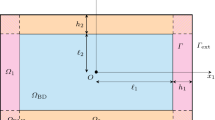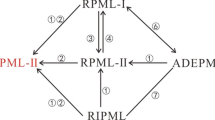Abstract
Multi-axial perfectly matched layer (M-PML), known to have lost the perfect-matching property owing to multi-axial coordinate stretching, has been numerically validated to be long-time stable and it is thus used extensively in linear anisotropic wave simulation and in isotropic cases where the PML becomes unstable. We are concerned with the construction of the M-PML for anisotropic wave simulation based on a second order wave equation implemented with the displacement-based numerical method. We address the benefit of the incorrect chain rule, which is implicitly adopted in the previous derivation of the M-PML. We show that using the frequency-shifted stretching function improves the absorbing efficiency of the M-PML for near-grazing incident waves. Then, through multi-axial complex-coordinate stretching the second order anisotropic wave equation in a weak form, we derive a time-domain multi-axial unsplit frequency-shifted PML (M-UFSPML) using the frequency-shifted stretching function and the incorrect chain rule. A new approach is provided to reduce the number of memory variables needed for computing convolution terms in the M-UFSPML. The obtained M-UFSPML is well suited for implementation with a finite element or the spectral element method. By providing several typical examples, we numerically verify the accuracy and long-time stability of the implementation of our M-UFSPML by utilizing the Legendre spectral element method.
Similar content being viewed by others

References
Almqvist BS and Mainprice D (2017), “Seismic Properties and Anisotropy of the Continental Crust: Predictions Based on Mineral Texture and Rock Microstructure,” Reviews of Geophysics, 55(2): 367–433.
Babuška V and Cara M (1991), Seismic Anisotropy in the Earth (Vol. 10), Springer Science and Business Media, Germany.
Bao H, Bielak J, Ghattas O, Kallivokas LF, O’Hallaron DR, Shewchuk JR and Xu J (1998), “Large-Scale Simulation of Elastic Wave Propagation in Heterogeneous Media on Parallel Computers,” Computer Methods in Applied Mechanics and Engineering, 152(1–2): 85–102.
Bécache E, Fauqueux S and Joly P (2003), “Stability of Perfectly Matched Layers, Group Velocities and Anisotropic Waves,” Journal of Computational Physics, 188(2): 399–433.
Bérenger JP (1994) “A Perfectly Matched Layer for the Absorption of Electromagnetic Waves,” Journal of Computational Physics, 114(2): 185–200.
Bindel DS and Govindjee S (2005), “Elastic PMLs for Resonator Anchor Loss Simulation,” International Journal for Numerical Methods in Engineering, 64(6): 789–818.
Carcione JM (2015), Wave Fields in Real Media: Wave Propagation in Anisotropic, Anelastic, Porous and Electromagnetic Media, Elsevier, Netherlands.
Cerjan C, Kosloff D, Kosloff R and Reshef M (1985), “A Nonreflecting Boundary Condition for Discrete Acoustic and Elastic Wave Equations,” Geophysics, 50(4): 705–708.
Cerveny V (2005), Seismic Ray Theory, Cambridge University Press, UK.
Collino F and Tsogka C (2001), “Application of the Perfectly Matched Absorbing Layer Model to the Linear Elastodynamic Problem in Anisotropic Heterogeneous Media,” Geophysics, 66(1): 294–307.
Deuss A, Irving JC and Woodhouse JH (2010), “Regional Variation of Inner Core Anisotropy from Seismic Normal Mode Observations,” Science, 328(5981): 1018–1020.
Diez A and Eisen O (2015), “Seismic Wave Propagation in Anisotropic Ice-Part 1: Elasticity Tensor and Derived Quantities from Ice-Core Properties,” The Cryosphere, 9(1): 367–384.
Dmitriev MN and Lisitsa VV (2011), “Application of M-PML Reflectionless Boundary Conditions to the Numerical Simulation of Wave Propagation in Anisotropic Media, Part I: Reflectivity,” Numerical Analysis and Applications, 4(4): 271–280.
Duru K and Kreiss G (2014), “Numerical Interaction of Boundary Waves with Perfectly Matched Layers in Two Space Dimensional Elastic Waveguides,” Wave Motion, 51(3): 445–465.
Fathi A, Poursartip B and Kallivokas LF (2015), “Time-Domain Hybrid Formulations for Wave Simulations in Three-Dimensional PML-Truncated Heterogeneous Media,” International Journal for Numerical Methods in Engineering, 101: 165–198.
Festa G and Vilotte JP (2005), “The Newmark Scheme as Velocity-Stress Time-Staggering: an Efficient PML Implementation for Spectral Element Simulations of Elastodynamics,” Geophysical Journal International, 161(3): 789–812.
Gao K and Huang L (2017), “Optimal Damping Profile Ratios for Stabilization of Perfectly Matched Layers in General Anisotropic Media,” Geophysics, 83(1): T15–T30.
Halpern L, Petit-Bergez S and Rauch J (2011), “The Analysis of Matched Layers,” Confluentes Mathematici, 3(02): 159–236.
Komatitsch D, Barnes C and Tromp J (2000), “Simulation of Anisotropic Wave Propagation Based upon a Spectral Element Method,” Geophysics, 65(4): 1251–1260.
Komatitsch D and Martin R (2007), “An Unsplit Convolutional Perfectly Matched Layer Improved at Grazing Incidence for the Seismic Wave Equation,” Geophysics, 72(5): SM155–SM167.
Komatitsch D and Tromp J (1999), “Introduction to the Spectral Element Method for Three-Dimensional Seismic Wave Propagation,” Geophysical Journal International, 139(3): 806–822.
Komatitsch D and Tromp J (2003), “A Perfectly Matched Layer Absorbing Boundary Condition for the Second Order Seismic Wave Equation,” Geophysical Journal International, 154(1): 146–153.
Li Y and Bou Matar O (2010), “Convolutional Perfectly Matched Layer for Elastic Second Order Wave Equation,” The Journal of the Acoustical Society of America, 127(3): 1318–1327.
Liao ZP, Wong HL, Yang BP and Yuan YF (1984), “A Transmitting Boundary for Transient Wave Analysis,” Science in China Series A-Mathematics Physics Astronomy and Technological Science, 27(10): 1063–1076.
Liu H and Zhang H (2019), “Reducing Computation Cost by Lax-Wendroff Methods with Fourth Order Temporal Accuracy,” Geophysics, 84(3): T109–T119.
Ma S and Liu P (2006), “Modeling of the Perfectly Matched Layer Absorbing Boundaries and Intrinsic Attenuation in Explicit Finite-Element Methods,” Bulletin of the Seismological Society of America, 96(5): 1779–1794.
Martin R, Komatitsch D and Gedney SD (2008), “A Variational Formulation of a Stabilized Unsplit Convolutional Perfectly Matched Layer for the Isotropic or Anisotropic Seismic Wave Equation,” Comput. Model. Eng. Sci, 37(3): 274–304.
Matuszyk PJ and Demkowicz LF (2013), “Parametric Finite Elements, Exact Sequences and Perfectly Matched Layers,” Computational Mechanics, 51(1): 35–45.
Meza-Fajardo KC and Papageorgiou AS (2008), “A Nonconvolutional, Split-Field, Perfectly Matched Layer for Wave Propagation in Isotropic and Anisotropic Elastic Media: Stability Analysis,” Bulletin of the Seismological Society of America, 98(4): 1811–1836.
Moczo P, Kristek J, Vavrycuk V, Archuleta RJ and Halada L (2002), “3D Heterogeneous Staggered-Grid Finite-Difference Modeling of Seismic Motion with Volume Harmonic and Arithmetic Averaging of Elastic Moduli and Densities,” Bulletin of the Seismological Society of America, 92(8): 3042–3066.
Panji M, Kamalian M, Asgari MJ and Jafari MK (2014), “Analysing Seismic Convex Topographies by a Half-Plane Time-Domain BEM,” Geophysical Journal International, 197(1): 591–607.
Ping P, Zhang Y and Xu Y (2014), “A Multiaxial Perfectly Matched Layer (M-PML) for the Long-Time Simulation of Elastic Wave Propagation in the Second Order Equations,” Journal of Applied Geophysics, 101: 124–135.
Ping P, Zhang Y, Xu Y and Chu R (2016), “Efficiency of Perfectly Matched Layers for Seismic Wave Modeling in Second Order Viscoelastic Equations,” Geophysical Journal International, 207(3): 1367–1386.
Savage MK (1999), “Seismic Anisotropy and Mantle Deformation: What Have We Learned from Shear Wave Splitting?” Reviews of Geophysics, 37(1): 65–106.
Sayers CM (2018), “Elastic Anisotropy of Polycrystalline Ice with Transversely Isotropic and Orthotropic Symmetry,” Geophysical Journal International, 215(1): 155–164.
Semblat JF, Lenti L and Gandomzadeh A (2011), “A Simple Multi-Directional Absorbing Layer Method to Simulate Elastic Wave Propagation in Unbounded Domains,” International Journal for Numerical Methods in Engineering, 85(12): 1543–1563.
Stacey R (1988), “Improved Transparent Boundary Formulations for the Elastic-Wave Equation,” Bulletin of the Seismological Society of America, 78(6): 2089–2097.
Sochacki J, Kubichek R, George J, Fletcher WR and Smithson S (1987), “Absorbing Boundary Conditions and Surface Waves,” Geophysics, 52(1): 60–71.
Xie ZN, Komatitsch D, Martin R and Matzen R (2014), “Improved Forward Wave Propagation and Adjoint-Based Sensitivity Kernel Calculations Using a Numerically Stable Finite-Element PML,” Geophysical Journal International, 198(3): 1714–1747.
Xie ZN, Matzen R, Cristini P, Komatitsch D and Martin R (2016), “A Perfectly Matched Layer for Fluid-Solid Problems: Application to Ocean-Acoustics Simulations with Solid Ocean Bottoms,” The Journal of the Acoustical Society of America, 140(1): 165–175.
Xie ZN and Zhang XB (2017), “Weak-Form Time-Domain Perfectly Matched Layer,” Chinese Journal of Geophysics, 60(10): 3823–3831.
Zeng C, Xia J, Miller RD and Tsoflias GP (2011), “Application of the Multiaxial Perfectly Matched Layer (M-PML) to Near-Surface Seismic Modeling with Rayleigh Waves,” Geophysics, 76(3): T43–T52.
Zhang W and Shen Y (2010), “Unsplit Complex Frequency-Shifted PML Implementation Using Auxiliary Differential Equations for Seismic Wave Modeling,” Geophysics, 75(4): T141–T154.
Zhao M, Wu L, Du X, Zhong Z, Xu C and Li L (2018), “Stable High-Order Absorbing Boundary Condition Based on New Continued Fraction for Scalar Wave Propagation in Unbounded Multilayer Media,” Computer Methods in Applied Mechanics and Engineering, 334: 111–137.
Zhebel E, Minisini S, Kononov A and Mulder WA (2014), “A Comparison of Continuous Mass-Lumped Finite Elements with Finite Differences for 3-D Wave Propagation,” Geophysical Prospecting, 62(5): 1111–1125.
Zhu H, Komatitsch D and Tromp J (2017), “Radial Anisotropy of the North American Upper Mantle Based on Adjoint Tomography with USArray,” Geophysical Journal International, 211(1): 349–377.
Zhu T (2017) “Numerical Simulation of Seismic Wave Propagation in Viscoelastic-Anisotropic Media Using Frequency-Independent Q Wave Equation,” Geophysics, 82(4): WA1–WA10.
Acknowledgement
This study was funded by the Scientific Research Fund of the Institute of Engineering Mechanics, China Earthquake Administration (No. 2021EEEVL0102); the National Natural Science Foundation of China (Nos. U2039209; 51808516); the National Key RandD Program of China (No. 2018YFC1504004); and the Distinguished Young Scholars Program of the Natural Science Foundation of Heilongjiang province, China (No. YQ2020E005). Zhinan mourns for Dimitri Komatitsch, a visionary computational geophysicist and a great teacher.
Author information
Authors and Affiliations
Corresponding author
Additional information
Supported by: Scientific Research Fund of Institute of Engineering Mechanics, China Earthquake Administration under Grant No. 2021EEEVL0102, National Natural Science Foundation of China under Grant Nos. U2039209 and 51808516, the National Key R&D Program of China under Grant No. 2018YFC1504004, and Distinguished Young Scholars Program of the Natural Science Foundation of Heilongjiang province, China under Grant No. YQ2020E005
Rights and permissions
About this article
Cite this article
Xie, Z., Zheng, Y., Cristini, P. et al. Multi-axial unsplit frequency-shifted perfectly matched layer for displacement-based anisotropic wave simulation in infinite domain. Earthq. Eng. Eng. Vib. 22, 407–421 (2023). https://doi.org/10.1007/s11803-023-2170-3
Received:
Accepted:
Published:
Issue Date:
DOI: https://doi.org/10.1007/s11803-023-2170-3



